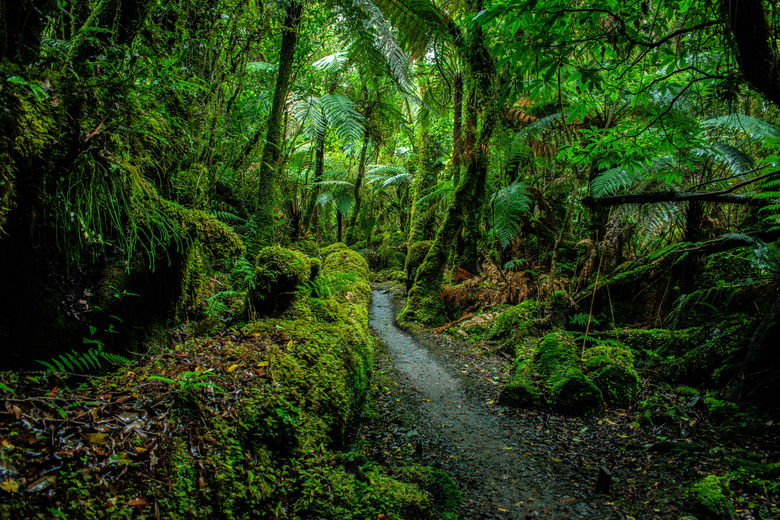Description Of An Ecosystem
One of the main topics of ecology concerns defining ecosystems. An ecosystem is any geographic area where abiotic and biotic factors interact. Large-scale ecosystems are often broken up into broad categories depending on the environment, such as coral reefs, rainforests, tundra and grasslands.
Abiotic Factors in an Ecosystem
Abiotic Factors in an Ecosystem
In ecological terms, abiotic factors are those parts of an ecosystem that are non-living. Examples of abiotic components include water, soil, air, light and temperature. In aquatic environments, water-based abiotic factors also include water movement and currents (or lack thereof).
In terrestrial environments, which are land-based, a major abiotic factor that affects an area is the weather. Wind speeds, the quantity of rain, or the presence of snow vastly alter the environment living creatures must adapt to.
Abiotic resources are usually present naturally, but some may be artificial. For example, a common conservation tactic to rebuild coral reefs is to create a suitable substrate for coral polyps to attach themselves to. Artificial reef structures are made of many materials, including concrete and metal. In this example, the natural resources would include ocean water, sand, temperature and local currents.
Biotic Factors in an Ecosystem
Biotic Factors in an Ecosystem
Biotic factors in an ecosystem are parts of the ecosystem that are living. Biotic components include plants, animals, fungi, bacteria, microscopic organisms and perhaps viruses, although they technically aren't classified as alive.
Ecologists examine how biotic factors interact with other biotic factors and abiotic components when looking at the structure and function of an ecosystem. Ecological relationships between biotic factors include competition, predation and symbiosis.
Competition is when two organisms both rely on the same abiotic or biotic resource. Predation refers to when a predator eats another living thing. Two different organisms living in symbiosis have a close relationship with each other. Symbiosis is broken down further into mutualism, commensalism and parasitism.
Mutualism is a symbiotic relationship where both organisms benefit from this close relationship. Commensalism is where one organism benefits, but the other isn't harmed in the process. In a parasitic relationship, one organism benefits and the other is harmed, but not always killed.
Ecosystem Details and Examples
Ecosystem Details and Examples
On a large scale, the entire Earth is an ecosystem because every interaction between living things and their environment has a ripple effect across the planet in one way or another. Narrowing down geographic size, ecosystems are split into various biomes as ecological relationships within them are often similar, regardless of where in the world that biome is located. There are five main types of biomes on Earth: aquatic, grassland, forest, tundra and desert. Furthermore, aquatic ecosystems can be freshwater (such as rivers and lakes) or saltwater (coral reefs, mangroves, or deep-sea vents).
On a smaller scale, each person has a unique ecosystem of microorganisms across and within their body. The interactions of microbial ecosystems, referred to as the microbiome, greatly impact our health. In recent years more research has gone into understanding how different communities of microorganisms in humans' digestive tracts influence everything from mood to rates of depression and immune system health.
Defining an ecosystem is difficult as the movement of biotic organisms is fluid. For example, a whale's ecosystem spans oceans as they migrate from cooler waters where food is abundant to warmer oceans to birth their calves. Compare this to small tropical reef fish that share the same area as the whale at certain times of the year but spend their entire lives in and around one sea anemone.
Ecosystem Services
Ecosystem Services
Ecosystem services are the gains humans get from healthy ecosystems. Provisioning services include food, drinking water, fuel, medicines, materials to build technology, clothing and housing. Regulatory services make life for humans possible, including clean air produced by plants, waste decomposed by bacteria, tree roots preventing soil erosion, bees pollinating flowers and climate regulation.
Cultural services are the ways ecosystems inspire creativity, building knowledge and recreation. These services influence art, music, philosophy, and scientific discoveries resulting in societal, intellectual and cultural development. The final category is supporting services; these are often overlooked but vital to survival on Earth. Supporting services include fundamental natural processes like photosynthesis, soil production, nutrient recycling and the water cycle.
References
- National Geographic: Abiotic Factors
- National Geographic: Biome
- Smithsonian Ocean: Whales
- Zoological Society of London: Ecosystems Under the Microscope: Why Microbes Matter for Conservation
- National Geographic: Ecological Relationships
- New Heaven Reef Conservation: Artificial Reefs: What Works and What Doesn't
- National Geographic: Biotic Factors
- The National Wildlife Federation: Ecosystem Services
Cite This Article
MLA
Jerrett, Adrianne. "Description Of An Ecosystem" sciencing.com, https://www.sciencing.com/facts-5765687-description-ecosystem/. 30 September 2021.
APA
Jerrett, Adrianne. (2021, September 30). Description Of An Ecosystem. sciencing.com. Retrieved from https://www.sciencing.com/facts-5765687-description-ecosystem/
Chicago
Jerrett, Adrianne. Description Of An Ecosystem last modified August 30, 2022. https://www.sciencing.com/facts-5765687-description-ecosystem/
